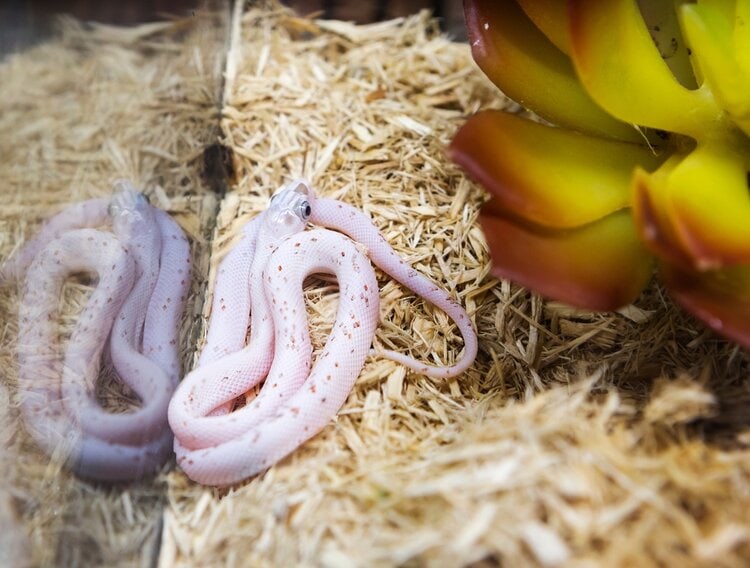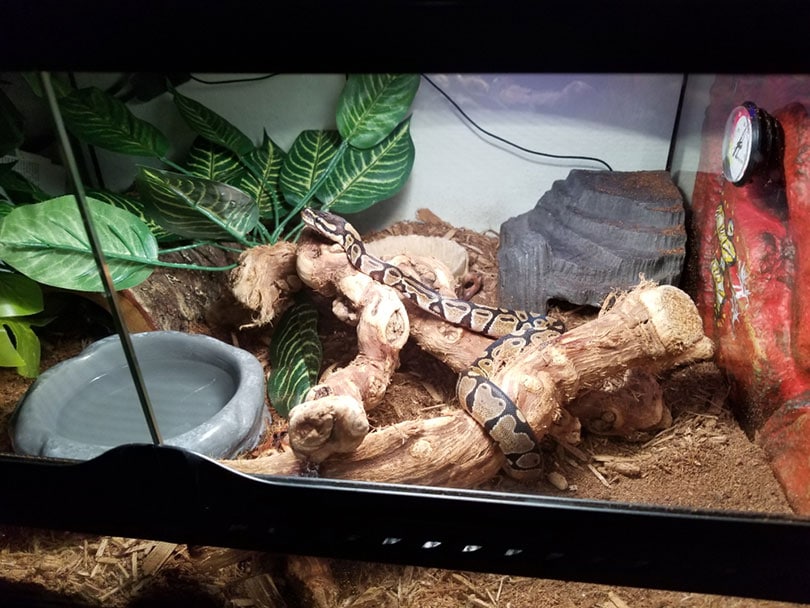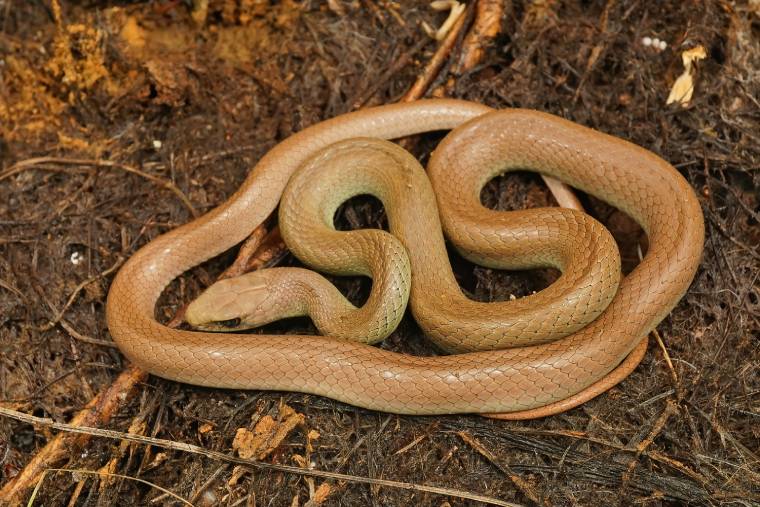
The corn snake is a popular pet among snake enthusiasts. It’s relatively docile and easy to care for due to its manageable size. The origin of their name is uncertain: corn snakes either got their name from their corn kernel-type look on their scales or from their tendencies to hang around corn stockpiles (due to the mice that the corn attracted).
The Palmetto corn snake is just one of many color variations of corn snakes. The name comes from the state it was first captured in: South Carolina, the palmetto state. They are all white with spots of red or black scales. They are bred from two heterozygous corn snakes (het corn snakes for short) and carry the recessive gene necessary for their scale color.
Quick Facts about Palmetto Corn Snake
| Species Name: | Pantherophis guttatus |
| Common Name: | Corn snake |
| Care Level: | Low |
| Lifespan: | 15 – 20 years |
| Adult Size: | 3 – 5 feet long |
| Diet: | Mice and rats |
| Minimum Tank Size: | 20 gallons |
| Temperature & Humidity: | 70 – 85 degrees F, 50% humidity |
Do Palmetto Corn Snakes Make Good Pets?
Yes, corn snakes make great pets, especially for those beginning to own pet snakes as a hobby. They are relatively small among the snake species and do not possess enough venom to cause harm to humans. In the wild, they constrict their prey to have their meals, meaning they don’t need to use their fangs to kill. Most people can handle them with ease.
Corn snakes also only need to be fed once a week, and their tank maintenance is fairly low. All these reasons make palmetto corn snakes fairly easy to keep.
Appearance
Palmetto corn snakes are pinkish with barely-visible dots as juveniles, but as they grow up and shed their skin more and more, they become a vibrant white color with black and red spots. They grow up to 5 feet long and get as thick as a paper towel roll.
Palmettos are specifically bred for their unique look, but corn snakes come in a huge variety of colors, from lavender to sunkissed, to blood red, to anerythristic, and more.
How to Take Care of Palmetto Corn Snake
Tank
The minimum size for your Palmetto corn snake’s new tank home is 20 gallons. Preferably you get one that is long and shallow, like a long rectangle, as opposed to a more square-shaped one. It’s imperative that the lid on your tank is secure as snakes are notorious for escaping out of their tanks. The best kinds of lids securely lock down with clamps.
Your snake also will want some places to hide when he is in the tank. Any cardboard box with a hole cut in it would do, but you can also purchase special hides like a fake log or a cave
Clean the entire tank and items inside once a month and spot clean every day. You can use hot water and antibacterial soap, but if there’s stuff that won’t come out with that, you can soak in a bleach solution overnight.
Heating
Corn snakes, including palmetto corn snakes, are from temperate climates. Extreme heat (like what tropical snakes need) is not necessary for corn snakes. Keep a heat lamp on top set to 88 – 92 degrees F for the basking area. Heating pads can be used, but it’s difficult to monitor the temperature this way.
Humidity
These snakes do not require more humidity than your house already has. They will do fine in as low as 40% humidity, however, they will stay most hydrated and maintain best shedding practices if their tank is at least 60% humidity.
Substrate
A first layer should be at the bottom of your tank to keep it clean. Newspaper works because it’s easy to switch out, but it’s not very nice to look at. Astroturf can be used too.
Corn snakes love to burrow, so a loose substrate is best to put on top of that. Aspen shavings work well. Aspen is the only kind of substrate that will not interfere with your snake’s health.
Simply scoop out soiled shavings whenever you see them. Keep your tank even cleaner by removing the snake and putting him in a different, smaller tank for feeding time.
Tank Recommendations
| Tank Type: | 20-gallon long glass vivarium |
| Lighting: | N/A |
| Heating: | Heating lamp, 70 – 88 degrees F |
| Best Substrate: | Aspen shavings |
Feeding Your Palmetto Corn Snake
Feeding a corn snake is pretty straightforward: for adults, feed one mouse a week. You can purchase frozen mice and let one thaw the night before you feed it to your snake. The size of the mouse can be as big as your snake’s head or slightly bigger.
Smaller, growing snakes will need to be fed twice a week instead, and baby snakes can start with pinky mice for food.
Diet Summary
| Fruits: | 0% of diet |
| Insects: | 0% of diet |
| Meat: | 100% of diet – small/medium-sized rodents |
| Supplements Required: | N/A |
Keeping Your Palmetto Corn Snake Healthy
If the temperatures are right, you are feeding your snake regularly, and the tank is kept clean, your palmetto corn snake will be happy for many years.
Providing a water source for your corn snake is a must. Snakes utilize these for defecation, as well as a nice soak before they shed.
Even when you do your best to keep your snake healthy, sometimes they develop health issues. Here are some of the most common ones.
Mouth Rot
Also called infectious stomatitis, mouth rot is a bacterial infection. It causes inflammation in the mouth and can even reach the bone if left untreated.
Fungal Disease
Fungal disease among snakes is becoming more and more common in North America. It’s characterized by flaking of the scales, swelling, and discoloration. Visit your exotic pet vet when you notice something off about your snake’s skin, and treatment will be prescribed.
Lifespan
Palmetto corn snakes, like other corn snakes, live to be anywhere from 6 to 23 years old. The oldest recorded corn snake was 32 years and 3 months old before it passed.
Breeding
In terms of reptile breeding, it’s fairly easy to breed corn snakes. Palmetto corn snakes are a little more complicated to get, though. They can be bred from two get snakes to form the palmetto color.
In the wild, corn snakes breed right after the wintertime cooling takes place. In captivity, one can recreate this “season” by brumating the snakes for a number of days. A male snake then courts a female snake, they mate, and the female lays 12-24 eggs about a month later. Once the eggs are laid, the female will not return to them.
Are Palmetto Corn Snakes Friendly? Our Handling Advice
In the short history of palmetto corn snakes, most of them are friendly towards humans. This is typical of all corn snakes. They tolerate handling well.
This is how you handle a corn snake: gently hold them up under their body with both hands, one near the head and one near the tail. Never grab the snake, and always return the snake to its tank after 10 or 15 minutes. Otherwise, their core body temperature will drop too low.
Shedding & Brumation: What to Expect
Juvenile corn snakes shed every 4-6 weeks, while adults shed only once every 3 months or so. When shedding is about to happen, you will notice that your snake’s eyes become cloudy. Also, they will likely not eat as much right before shedding time. You may notice that your snake likes to take a soak in the water dish before it happens, too.
In captivity, snakes will not brumate as long as you feed them regularly and keep their temperatures normal. It will not hurt them to not encourage brumation, although some snake owners like to do this to keep them in tune with the seasons.
How Much Do Palmetto Corn Snakes Cost?
More common corn snakes are around $20-$50 dollars, however, the palmetto is a rare breed and will cost more. You should expect to pay between $500 to $1,000 for a single palmetto corn snake.
Care Guide Summary
Summary
Corn snakes come in various colors, one of the most beautiful and rare ones being the palmetto coloring. If you’re lucky enough to find one, you will have a friendly companion for many years if you take care of them the right way.
Featured Image Credit: Galina Savina, Shutterstock










